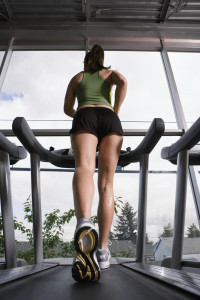What is the biggest mistake you are making when training for fat loss? For a moment, let’s forget about your nutrition and talk specifically about your workouts. Are you being consistent, following a plan and still not seeing results?
This is the reason why: It’s been scientifically proven, on a number of occasions. We’ve been reading this literature for years and I’ve tried and tested both theories on myself, and my clients.
The problem is long, slow cardio and aerobics.
Love going out for a nice steady run, enjoying the park, the sunshine and getting a dose of inspiration? It’s by no means easy. You get sweaty. Hot. Tired but not exhausted. You spend 30-40 minutes with your heart rate elevated, but it’s far from your capacity.
So what’s the problem with this workout and WHY are you not losing body fat? Welcome to the dark side of cardio. It has been drilled into us since we were little kids that exercising in the “fat-burning zone” is best for fat loss.
But it’s not effective.
How Can This Be Happening?
Unfortunately, your body is against you in the quest to lose fat. You see, it wants to be efficient as possible. This means it will adapt to whatever exercise you are doing, in order to reach equilibrium and maintain efficiency. So how does this relate to you — when you start working out or change your program, you will see changes in your body within the first 4-6 weeks. Remember results vary and everyone is different. But, if you continue to do the same workouts, same intensity (like long, slow cardio) along comes the dreaded plateau. You will no longer see results and your body becomes an efficient fat-storing machine.
Bad news.
Marathon Training: The Ugly Side of Cardio
The reality of the fat loss cardio myth really hit home for me after I ran my first marathon. The part that really got me was the training time vs training effect. I would do training runs for 2-3 hours most weekends, averaging 30-45 miles a week. Sure, I was in fantastic cardiovascular shape and I was losing weight. But the belly fat was sticking around!!
My muscles were disappearing right before my eyes. My arms and stomach were soft – kind of like marshmallow – even though I was doing resistance training! Most long run workouts would burn 1300-2000 calories. That’s a LOT. I did a number crunch after the last NYC marathon. I burnt 49,289 calories in 3 months of endurance running training, which in theory, equals 14 pounds of fat!
So that didn’t happen… And I was totally amazed at how little body fat I lost.
This personally, was the final nail in the aerobics coffin.
In fact, you have to be extra careful not to overeat calories when training for an endurance event. Many people think it’s an opportunity to enjoy an open buffet of carbs at every meal. You see, it will make you hungry and doing high volume steady state exercise can potentially backfire on you.
When I started endurance training, I would wake up in the middle of the night absolutely starving. By 4am I was so hungry I could eat 1000 bagels. OK maybe not that many, but I was really hungry. If you’re not careful, you can very easily overeat. So if anything, I think long, slow exercise makes fat loss MORE difficult. You really need to watch your calorie intake.
One Exercise to Accelerate Fat Loss
As you may have discovered, particularly from my marathon adventures – long, slow cardio is not so efficient.
The workout solution is not complicated. But it is HARD work. And the winner is:
High-Intensity Interval Training!
We’re going on a cardio-free diet. Step away from the treadmill and the other gym machines. And we’re not just talking about doing sprints. That’s far too boring.
To burn fat AND build muscle at the same time you need to try metabolic resistance training.
You know these short intense workouts are not easy to do. But they do produce the results. You have to psych yourself up. You need a plan. You need drive and willpower. You need to bring it. This is not the type of workout you can do half asleep, watching TV or while you read a book.
A quick and easy way to gauge your intensity is based on how you feel. If it feels easy, no matter what you’re doing, IT IS. Even though the trusty elliptical machine said you burnt 100 calories in 10 minutes, I doubt it. If it was easy, it’s highly unlikely you really burnt that many calories.
The Proof
Like I said, high intensity interval training for fat loss has been proven in the literature for many years. There’s a ton of research to show it’s the most effective way to burn fat. I won’t bore you with all of it today – just a quick review.
A landmark study from UNSW (where I went to University!) showed women who performed 20 minutes of interval training on a stationary bike (8s sprint, 12s recovery), 3 days per week for 15 weeks lost an average of 5.5 pounds (without dieting). Whereas the group who performed 40 minutes steady state cycling – gained a pound of fat over the same period! (1)
Another interesting study in 2007 showed the effect of seven high-intensity interval training sessions over two weeks. The women in the study had an increase in fat-burning enzymes and boosted their ability to burn fat during exercise by 36%. (2)
My Solution
Post marathon, I switched gears to get my muscles and strength back. I eliminated all steady state exercise and embarked on a 12 week program I created. It consisted of 5 workouts/week (Monday-Friday) with a combination of intervals, strength training and metabolic circuits. And voila, within 2 weeks I was seeing results! My muscles were appearing again and even my abs were back. The best part – my workouts were less than 45 minutes! Another example it’s all about your intensity.
Metabolic Resistance Training
The secret to success is an upcoming workout method that gets serious results in a timely fashion.
It is a great way to do interval training without the treadmill/elliptical/bike. The short definition of metabolic resistance training is the use of total body movements (instead of isolated exercises), working at intensity for 30-60s with minimal rest breaks to maximize calorie burn and increase metabolic response.
At the end of your resistance training session, add a metabolic circuit to maximize your post workout afterburn, boost your metabolism and continue burning calories for the next 24-48 hours. The series of moves gets your heart pumping and can last anywhere from 2-12 minutes total. One of the huge benefits – you don’t need any machines. So you don’t even need to be at the gym.
Instead of doing your regular cardio workouts this week, give this circuit a try! Do all the exercises in order and choose your intensity based on your current fitness level.
Beginner: Work 30s-Rest 30s. Rest for 2 mins at end then repeat.
Intermediate: Work 30s-Rest 15s. Rest for 90s at end then repeat 1-3 rounds.
Advanced: Work 45s-Rest 15s. Rest for 1 min at end then repeat 2-3 rounds.
1A) Jump Rope
1B) Lunge with Overhead Reach
1C) Push Ups
1D) Bodyweight Squat
2A) Jumping Jacks
2B) Alternating Step Ups
2C) Mountain Climbers
2D) KB/DB Swing
Find Your Solution…
Decide what you are training for. What is your personal goal? If you are doing an endurance event, of course you need to do long slow cardio training to build your capacity. Otherwise you simply won’t achieve your goal. I only do long steady state runs if I’m training for an endurance event, like a half or full marathon. I know I probably won’t lose body fat and that’s fine. It’s not the goal.
But if you want to lose fat, gain muscle strength, and don’t have a lot of time to workout – interval training and metabolic resistance training is the key to success.
Be effective and use your workout time wisely.
Have an awesome week!
KV
References:
1. Trapp, E.G., Chisholm, D.J., Freund, J., Boutcher, S.H. (2008). The effects of high-intensity intermittent exercise training on fat loss and fasting insulin levels of young women. International Journal of Obesity. 32(4):684–691.
2. Talanian, J.L., Galloway, S.D.R., Heigenhauser, G.J.F., Bonen, A., Spriet, L.L. (2007). Two weeks of high-intensity aerobic interval training increases the capacity for fat oxidation during exercise in women. Journal of Applied Physiology. 102(4):1439–1447
















One Reply